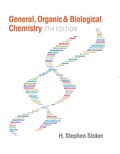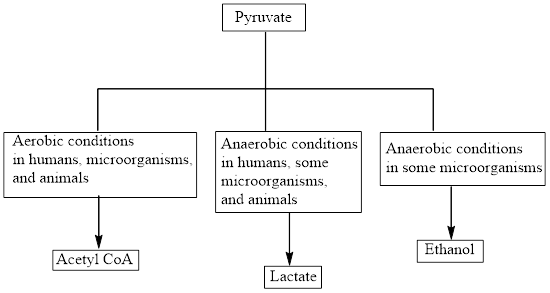
EBK GENERAL, ORGANIC, AND BIOLOGICAL CH
7th Edition
ISBN: 8220100853180
Author: STOKER
Publisher: CENGAGE L
expand_more
expand_more
format_list_bulleted
Concept explainers
Question
Chapter 24, Problem 24.42EP
Interpretation Introduction
Interpretation: To identify the fate of the third pyruvate carbon atom in the oxidation of pyruvate to acetyl CoA.
Concept introduction: Pyruvate is the end product in the glycolysis. The production of the fate of pyruvate varies with the nature of the organism and the cellular conditions. The three common fates of pyruvate are as follows:

Aerobic reactions need oxygen while anaerobic reactions don’t need oxygen. Pyruvate forms
Pyruvate
Expert Solution & Answer
Want to see the full answer?
Check out a sample textbook solution
Students have asked these similar questions
If the molar conductivity at infinite dilution of HAC is A0 = 390.5 S cm² mol¹. Calculate
the Arrhenius conductivity of a 9.3% by weight solution of HAc with a pH of 3.3. Data:
molecular weight of HAC is 60.05 g/mol and the density of the solution is 1 g/cm³.
If the molar conductivity at infinite dilution of HAC is A0 = 390.5 S cm² mol¹. Calculate
the Arrhenius conductivity of a 9.3% by weight solution of HAc with a pH of 3.3. Data:
molecular weight of HAC is 60.05 g/mol and the density of the solution is 1 g/cm³.
If the molar conductivity at infinite dilution of HAC is A0 = 390.5 S cm² mol¹. Calculate
the Arrhenius conductivity of a 9.3% by weight solution of HAc with a pH of 3.3. Data:
molecular weight of HAC is 60.05 g/mol and the density of the solution is 1 g/cm³.
Chapter 24 Solutions
EBK GENERAL, ORGANIC, AND BIOLOGICAL CH
Ch. 24.1 - The primary site within the human body where...Ch. 24.1 - What is the first site within the human body where...Ch. 24.1 - What effect does gastric juice in the stomach have...Ch. 24.1 - Prob. 4QQCh. 24.1 - Which of the following substances is needed for...Ch. 24.2 - Prob. 1QQCh. 24.2 - Prob. 2QQCh. 24.2 - Prob. 3QQCh. 24.2 - Prob. 4QQCh. 24.2 - Prob. 5QQ
Ch. 24.2 - Prob. 6QQCh. 24.2 - Prob. 7QQCh. 24.3 - Prob. 1QQCh. 24.3 - Prob. 2QQCh. 24.3 - Prob. 3QQCh. 24.3 - Prob. 4QQCh. 24.3 - Accumulation of which of the following substances...Ch. 24.4 - Prob. 1QQCh. 24.4 - The net yield of ATP for the complete oxidation of...Ch. 24.4 - Prob. 3QQCh. 24.5 - Prob. 1QQCh. 24.5 - Prob. 2QQCh. 24.5 - Prob. 3QQCh. 24.6 - Prob. 1QQCh. 24.6 - Prob. 2QQCh. 24.6 - Prob. 3QQCh. 24.6 - Which of the following statements about ATP...Ch. 24.6 - Prob. 5QQCh. 24.7 - Prob. 1QQCh. 24.7 - Prob. 2QQCh. 24.8 - Prob. 1QQCh. 24.8 - Prob. 2QQCh. 24.8 - Prob. 3QQCh. 24.9 - Which of the following hormones promotes the...Ch. 24.9 - Which of the following pairs of hormones increases...Ch. 24.10 - Prob. 1QQCh. 24.10 - Prob. 2QQCh. 24.10 - Prob. 3QQCh. 24 - Where does carbohydrate digestion begin in the...Ch. 24 - Very little digestion of carbohydrates occurs in...Ch. 24 - Prob. 24.3EPCh. 24 - Prob. 24.4EPCh. 24 - Prob. 24.5EPCh. 24 - Prob. 24.6EPCh. 24 - Prob. 24.7EPCh. 24 - Prob. 24.8EPCh. 24 - Prob. 24.9EPCh. 24 - Prob. 24.10EPCh. 24 - Prob. 24.11EPCh. 24 - Prob. 24.12EPCh. 24 - Prob. 24.13EPCh. 24 - Prob. 24.14EPCh. 24 - Prob. 24.15EPCh. 24 - Prob. 24.16EPCh. 24 - Prob. 24.17EPCh. 24 - Prob. 24.18EPCh. 24 - Prob. 24.19EPCh. 24 - Prob. 24.20EPCh. 24 - Prob. 24.21EPCh. 24 - Prob. 24.22EPCh. 24 - Prob. 24.23EPCh. 24 - Prob. 24.24EPCh. 24 - Prob. 24.25EPCh. 24 - Prob. 24.26EPCh. 24 - Prob. 24.27EPCh. 24 - Prob. 24.28EPCh. 24 - Prob. 24.29EPCh. 24 - Prob. 24.30EPCh. 24 - Prob. 24.31EPCh. 24 - Prob. 24.32EPCh. 24 - Prob. 24.33EPCh. 24 - Prob. 24.34EPCh. 24 - Prob. 24.35EPCh. 24 - Prob. 24.36EPCh. 24 - Prob. 24.37EPCh. 24 - Prob. 24.38EPCh. 24 - Prob. 24.39EPCh. 24 - Prob. 24.40EPCh. 24 - Prob. 24.41EPCh. 24 - Prob. 24.42EPCh. 24 - Prob. 24.43EPCh. 24 - Prob. 24.44EPCh. 24 - Prob. 24.45EPCh. 24 - Prob. 24.46EPCh. 24 - Prob. 24.47EPCh. 24 - Prob. 24.48EPCh. 24 - Prob. 24.49EPCh. 24 - Prob. 24.50EPCh. 24 - Prob. 24.51EPCh. 24 - Prob. 24.52EPCh. 24 - Prob. 24.53EPCh. 24 - Prob. 24.54EPCh. 24 - Prob. 24.55EPCh. 24 - Prob. 24.56EPCh. 24 - Prob. 24.57EPCh. 24 - Prob. 24.58EPCh. 24 - Prob. 24.59EPCh. 24 - Prob. 24.60EPCh. 24 - Prob. 24.61EPCh. 24 - Prob. 24.62EPCh. 24 - Prob. 24.63EPCh. 24 - Prob. 24.64EPCh. 24 - Prob. 24.65EPCh. 24 - The liver, but not the brain or muscle cells, has...Ch. 24 - Prob. 24.67EPCh. 24 - Prob. 24.68EPCh. 24 - Prob. 24.69EPCh. 24 - Prob. 24.70EPCh. 24 - Prob. 24.71EPCh. 24 - Prob. 24.72EPCh. 24 - Prob. 24.73EPCh. 24 - Prob. 24.74EPCh. 24 - Prob. 24.75EPCh. 24 - Prob. 24.76EPCh. 24 - Prob. 24.77EPCh. 24 - Prob. 24.78EPCh. 24 - Prob. 24.79EPCh. 24 - Prob. 24.80EPCh. 24 - Prob. 24.81EPCh. 24 - Prob. 24.82EPCh. 24 - Prob. 24.83EPCh. 24 - Prob. 24.84EPCh. 24 - Prob. 24.85EPCh. 24 - Prob. 24.86EPCh. 24 - Prob. 24.87EPCh. 24 - Prob. 24.88EPCh. 24 - Prob. 24.89EPCh. 24 - Prob. 24.90EPCh. 24 - Prob. 24.91EPCh. 24 - Prob. 24.92EPCh. 24 - Prob. 24.93EPCh. 24 - Prob. 24.94EPCh. 24 - Prob. 24.95EPCh. 24 - Prob. 24.96EPCh. 24 - Prob. 24.97EPCh. 24 - Prob. 24.98EPCh. 24 - Prob. 24.99EPCh. 24 - Prob. 24.100EPCh. 24 - Prob. 24.101EPCh. 24 - Prob. 24.102EPCh. 24 - Prob. 24.103EPCh. 24 - Prob. 24.104EPCh. 24 - Prob. 24.105EPCh. 24 - Prob. 24.106EPCh. 24 - Prob. 24.107EPCh. 24 - Prob. 24.108EPCh. 24 - Prob. 24.109EPCh. 24 - Prob. 24.110EPCh. 24 - Prob. 24.111EPCh. 24 - Prob. 24.112EPCh. 24 - Prob. 24.113EPCh. 24 - Prob. 24.114EPCh. 24 - Prob. 24.115EPCh. 24 - Compare the biological functions of glucagon and...Ch. 24 - Prob. 24.117EPCh. 24 - Prob. 24.118EP
Knowledge Booster
Learn more about
Need a deep-dive on the concept behind this application? Look no further. Learn more about this topic, biology and related others by exploring similar questions and additional content below.Similar questions
- Determine the distance between the metal and the OHP layer using the Helm- holtz model when the electrode's differential capacitance is 145 μF cm². DATA: dielectric constant of the medium for the interfacial zone &r= lectric constant of the vacuum &0 = 8.85-10-12 F m-1 = 50, die-arrow_forwardDescribe a sequence of photophysical processes that can be followed by radiation adsorbed by a molecule in the ground state to give rise to phosphorescent emission.arrow_forwardState two similarities between fluorescence and phosphorescence.arrow_forward
- State three photophysical processes that can be related to the effects of incident radiation on a molecule in its ground state. Consider that radiation can give rise to fluorescent emission, but not phosphorescent emission.arrow_forwardIn a photochemical reaction, how is the rate of the process related to its quantum yield?arrow_forwardPrimary and global quantum yields in photochemistry. Define them and give their formulas. Differentiate between them.arrow_forward
arrow_back_ios
SEE MORE QUESTIONS
arrow_forward_ios
Recommended textbooks for you
 Chemistry for Today: General, Organic, and Bioche...ChemistryISBN:9781305960060Author:Spencer L. Seager, Michael R. Slabaugh, Maren S. HansenPublisher:Cengage Learning
Chemistry for Today: General, Organic, and Bioche...ChemistryISBN:9781305960060Author:Spencer L. Seager, Michael R. Slabaugh, Maren S. HansenPublisher:Cengage Learning General, Organic, and Biological ChemistryChemistryISBN:9781285853918Author:H. Stephen StokerPublisher:Cengage Learning
General, Organic, and Biological ChemistryChemistryISBN:9781285853918Author:H. Stephen StokerPublisher:Cengage Learning Organic And Biological ChemistryChemistryISBN:9781305081079Author:STOKER, H. Stephen (howard Stephen)Publisher:Cengage Learning,
Organic And Biological ChemistryChemistryISBN:9781305081079Author:STOKER, H. Stephen (howard Stephen)Publisher:Cengage Learning,

Chemistry for Today: General, Organic, and Bioche...
Chemistry
ISBN:9781305960060
Author:Spencer L. Seager, Michael R. Slabaugh, Maren S. Hansen
Publisher:Cengage Learning

General, Organic, and Biological Chemistry
Chemistry
ISBN:9781285853918
Author:H. Stephen Stoker
Publisher:Cengage Learning

Organic And Biological Chemistry
Chemistry
ISBN:9781305081079
Author:STOKER, H. Stephen (howard Stephen)
Publisher:Cengage Learning,
